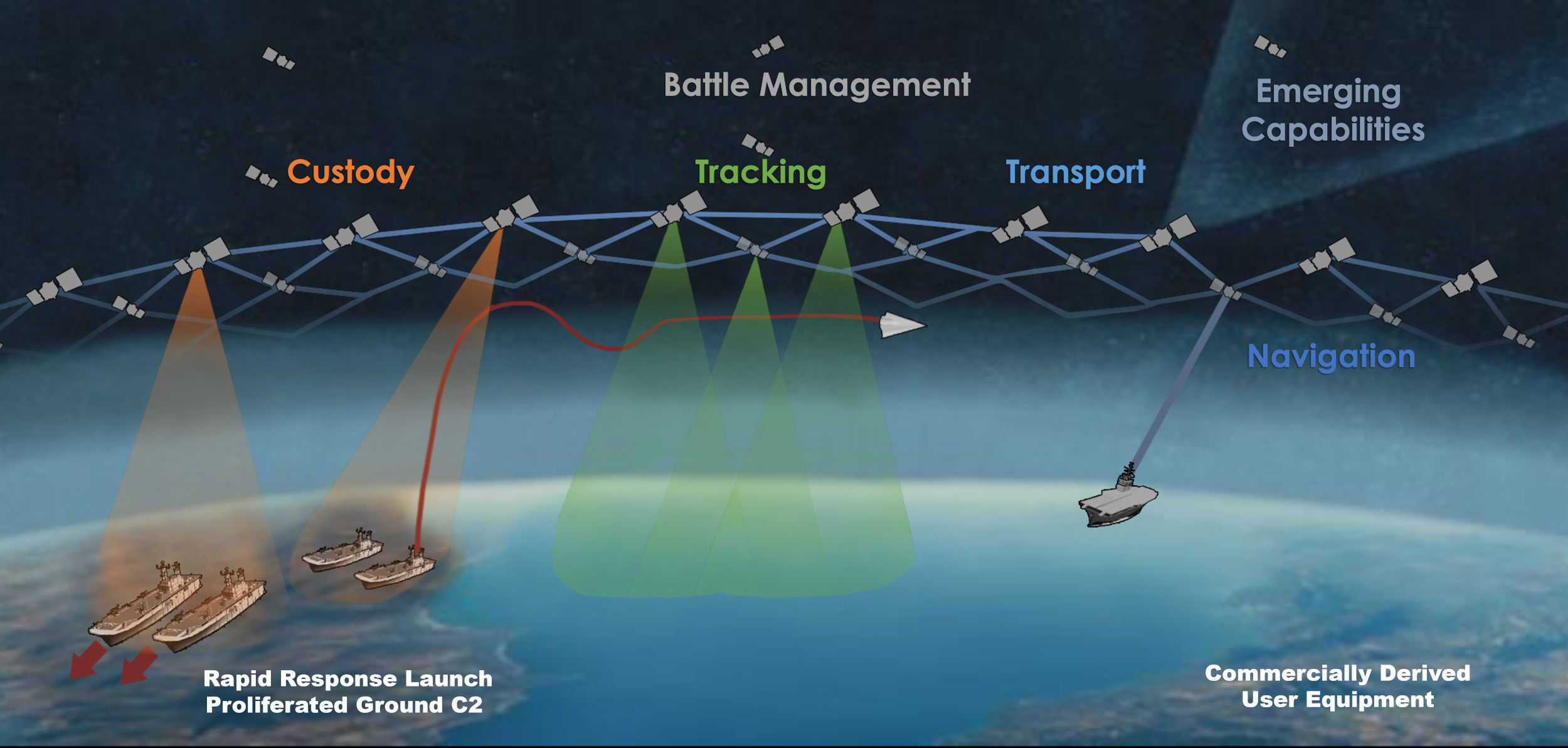Earth’s Orbit Is About to Get More Crowded
Sometime this coming March, a network of 10 small satellites winged with solar panels is scheduled to launch into Earth’s low orbit. Though likely invisible to the naked eye, the satellites will be part of a future herd of hundreds that, according to the Space Development Agency, or SDA, will bolster the United States’ defense capabilities.
The SDA, formed in 2019, is an organization under the United States Space Force, the newly formed military branch that operates and protects American assets in space. And like all good startups, the agency is positioned as a disruptor. It aims to change the way the military acquires and runs its space infrastructure. For instance, the forthcoming satellite network, called the National Defense Space Architecture, will collectively gather and beam information, track missiles, and help aim weapons, among other tasks.
The SDA’s vision both mimics and relies on shifts that started years ago in the commercial sector: groupings of cheap little satellites — often weighing hundreds of pounds, instead of thousands — that together accomplish what fewer big, expensive satellites used to.
Such sets of small satellites are called constellations, and those in low Earth orbit, which circle 1,200 miles or lower above Earth, can send data back and forth quickly. They rely on relatively inexpensive spacecraft that can be replaced and updated regularly. And they are hard to knock out, just like it’s more difficult to shoot down a flock of doves than a large turkey (or sitting duck).
The National Defense Space Architecture’s first spacecraft will launch from Vandenberg Space Force Base, part of the so-called Tranche 0, which will eventually total 28 interlinked satellites. “This tranche is incredibly important as sort of the trailblazer,” said Mike Eppolito, its program director. The launch was originally scheduled for September 2022, then delayed to December because of supply-chain issues, and delayed again until March to fix glitchy power supplies on eight of the satellites.
Now that the military has begun blazing this trail, it will also face the same challenges the commercial sector has recently had to reckon with: crowded orbits, potential collisions, and a sky filled with synthetic electromagnetic signals. Military and intelligence satellites haven’t proliferated at nearly the level of, say, those owned by SpaceX, and astronomers haven’t been paying as much attention to them. But an increased reliance on constellations will result in orbital emissions that can interfere with scientific research, and create an increased potential for collisions.
Even so, many experts believe confronting those challenges is possible. “The way we act in space is the way we should act in the neighborhood: Act responsibly, don’t litter, and pick up your trash,” said Darren McKnight, senior technical fellow at Leolabs, a private company that tracks objects in space and helps satellite operators steer away from possible crashes. “It’s not that hard. But if you just do one of the three things, it’s not sufficient.”
The Department of Defense is no stranger to space. In fact, the Army launched the first American satellite, Explorer 1, in 1958. For decades after, military and intelligence spacecraft dominated space, their payloads enabling surveillance, communications, navigation, and weather prediction, among other things.
But starting in 2017, a wave of private sector firms started launching more smaller satellites to low-earth orbit. Iridium, a communications provider, launched dozens of satellites that year. Other companies wanted to gather data, like Planet, which aimed to snap daily pictures of Earth, and Spire, which has sensors that keep track of weather, ships, and aircraft. In 2019, Elon Musk’s SpaceX launched its first Starlink communications satellites, designed to provide fast internet access across the globe. Today, several thousand Starlink satellites are operational, with plans for as many as 42,000. The next largest constellation, by the internet company OneWeb, will have around 7,000 satellites in orbit when their herd is complete in the future.
Though the Department of Defense had long been interested in the idea of small satellite constellations, it was only when these companies started to link lots of them together — to do the same kinds of jobs that the military had been doing — like taking snapshots of Earth, or providing data connectivity — that the military began to seriously pursue them.

The concept first appeared in the Defense Advanced Research Projects Agency. In 2017, the agency created a program called Blackjack, which sought to use commercial small-satellite technology for military purposes. “If they can build hundreds to potentially thousands of spacecraft, and do so at a point where they can offer a commercially compelling service, then the DOD should also look at how they can do that,” said Stephen Forbes, Blackjack’s current program manager.
At the time, not everyone was happy. “There was a lot of hesitancy within the department to do this huge shift in architectures,” said Derek Tournear, current director of the Space Development Agency, “from the Battlestar Galactica — very expensive, exquisite satellites” to herds of interlinked smaller ones. Within the Air Force, in particular, then-Secretary Heather Wilson publicly questioned whether constellations were as capable and hardy as their bigger and more complex forebears, particularly for missions like missile-warning and navigation.
Nevertheless, in 2019, Fred Kennedy, formerly the director of DARPA’s Tactical Technology Office, which ran the Blackjack program, left to become the first director of the new SDA. Its plans at the time were essentially a scaled-up version of Blackjack, with the goal of having satellites that could share data among one another and send it down to Earth better and faster, with up-to-date hardware and software, at a cheaper cost. (Kennedy resigned from his new post after just a few months.)
The SDA’s founding vision remains essentially the same. As such, its architecture will consist of multiple layers of satellites, with spacecraft someday in the hundreds. These layers will transport data to share information from different sensors; track missiles; provide an alternative to GPS; and tell weapons where to aim. They will also incorporate data from commercial satellites, said Tournear. The spacecraft being less expensive and more replaceable, the SDA can upgrade them regularly, whereas the older satellites have to wait a decade or more for replacement.
The military can now simply buy that up-to-date technology from companies like Lockheed Martin and York Space Systems. “We have some satellite companies that have been doing this before I was born,” said James Fernandez, SDA’s launch program manager, “and then we have others that are brand new.”
At the moment, though, the team is focused on ensuring the first Tranche 0 takeoff goes smoothly. “The launch vehicle can bring a satellite to a pile of pieces,” said Fernandez, who’s partly in charge of making sure those small spacecraft don’t break into smaller parts — space debris before they even make it there.
Meanwhile, space-traffic managers and astronomers, already coping with the proliferation of commercial constellations, are figuring out how best to navigate the more-crowded future.
For one thing, the sunlight that reflects off satellites’ surfaces, and the radio waves that satellites often use to transmit data, can show up in telescopes’ sensors back on Earth, marring the signals coming from stars, galaxies, and gases.
According to Jonathan McDowell of the Harvard-Smithsonian Center for Astrophysics, radio and optical astronomers began voicing concerns as far back as the 1980s, but it was only when SpaceX began launching its Starlink satellites that the issue went from annoying to problematic. Since then, astronomers like Meredith Rawls — a research scientist at the University of Washington and a member of a new international group called the Center for the Protection of the Dark and Quiet Sky from Satellite Constellation Interference — have been working to mitigate constellations’ negative effects on science and the sky’s purity. Yet the group doesn’t comment on military satellites and focuses on commercial constellations. Defense spacecraft, Rawls said, are “a total blindspot” for her.
“It’s taken 40 years to come to the point where it is a real problem,” said McDowell, who publishes an approximately monthly report of all space launches. Constellations, he noted, can become “a serious problem when you’re talking about not hundreds or even thousands of satellites, but tens of thousands.”
Tournear said his agency is paying close attention to sky-pollution concerns. The SDA’s architecture, he notes, is small compared to commercial ventures, with higher orbits than many other constellations, making its spacecraft dimmer from the ground’s perspective. “We’re not anywhere close to the density where we cause any kind of light flashes that you’ll be able to see our satellite optically from the ground,” he said, “so we shouldn’t cause any astronomy issues.”
And theoretically, at least, military satellites might be easier to deal with than commercial ones, since they have an interest in staying stealthier. McDowell, for one, said he isn’t worried at the moment. “From the point of view of astronomical impact, I don’t think the military is our concern right now,” he said.
But he and others do worry about potential collisions of satellites and space debris with the addition of military constellations. “Even a relatively small number of satellites whose orbits are secret, it’s problematic,” said McDowell, because managing space traffic requires knowing where it actually is.
Leolabs will keep track of the SDA’s objects, but the more satellites are in orbit, the more likely they are to crash — into each other or into the many pieces of litter already up there. “We can help you almost guarantee that you won’t get hit by a piece of trackable debris,” said McKnight of Leolabs. “Unfortunately, there are hundreds of thousands of objects that are too small for us or anybody to see. They can still kill you.”
That means it’s important for the SDA to build spacecraft that can recover from small smashups (and to have a plan for bringing down spacecraft that don’t survive, so they don’t create more debris). “I know that SDA understands how to do that,” said McKnight.
But they also have to contend as well with large pieces of existing space trash — spent rocket bodies the size of school buses, left over from American and Russian launches during the Cold War. “These clusters of massive derelict objects have a much greater debris-generating potential than any of these constellations do,” said McKnight. The constellations’ members, after all, can generally thrust away from danger. “These are small, very agile, very aware, and highly controlled and responsible satellites,” he continued.
But any crash creates tons of fragments (metal shards, bolts, paint chips, solar-panel shivs) that whiz around space, making other crashes even more likely, and creating tons more fragments. If two old rocket bodies hit each other, for example, a huge cloud of debris could come barreling at SDA satellites just as easily as they could Starlink’s. “They could affect these constellations drastically,” said McKnight.
Tournear takes debris concerns seriously. “It’s something that we’re tracking, and we’re certainly working with industry to help come up with ways to mitigate it,” he said. The agency, for instance, plans to bring its satellites down — or deorbit them — within five years of the end of their mission, reducing the trash above Earth and in line with a new federal rule. (Previously, spacecraft could whiz around for 25 years after their useful lifetimes.)
The SDA’s satellites will also live miles above the most crowded orbits, making collisions less likely. “I know they’re working very hard on having responsive systems that have a significant ability to do collision-avoidance maneuvers,” said McKnight.
Even if the military’s satellites don’t present problems on the level of commercial ones, the Department of Defense at the same time supports private proliferation. “It may not be a question of ‘Oh, the military are going to have massive constellations,’ but ‘the military are going to be customers of all of these massive constellations,’” said McDowell. The Air Force, for instance, just gave SpaceX a $1.9 million contract to test out one year of Starlink connectivity in Europe and Africa. And in early December, SpaceX announced a new business arm called Starshield, which will focus on providing satellite-constellation capabilities — like communications and Earth observation — to the government, for national security missions.
With all those objects in orbit, regardless of who owns them, responsible behavior — like keeping electromagnetic footprints low, not making trash, and picking up litter — is already key to keeping space safe. And it’s only going to become more important, because the future will likely include more small-satellite constellations from both the private sector and the military.
“I do think that this tranche is the start of a new way of doing business here,” said the SDA’s Eppolito. And the goal of Tranche 0, after its upcoming launch, is to prove that that way — small, quick, constellated, connected — is possible.
Tournear, however, isn’t quite ready to commit to that vision. He said he’s going to wait until the next generation, Tranche 1, is operational, around 2025: “That’s when I can say, ‘I told you.’”
Sarah Scoles is a freelance science journalist based in Denver, a contributing writer at Wired, and a contributing editor at Popular Science.












Comments are automatically closed one year after article publication. Archived comments are below.
There’s a lot of good points and accurate ideas in here, but the title is too dramatic and a bit misleading. Yes, SDA is launching hundreds of satellites, which is new for them (and relatively new for everyone else). But SDA’s Tranche 0 is laughably small compared to Starlink, who One Web is trying to match.
The thing this article fails to emphasize is orbital lifespan—something else Starlink has done is change the norms of responsible behavior. Their satellites are designed to deorbit in 5 years. If one of the many, cheaper satellites dies, it won’t be a problem for our grandkids’ grandkids. That’s a big change that SDA is also following. While SDA’s timelines aren’t as tight as 5 years, it’s much better than the lifespan of a GEO satellite! The cost vs capability is much lower, too. Something completely overlooked here.
There are plenty of creative ways to rip on SDA, but space junk isn’t the one.